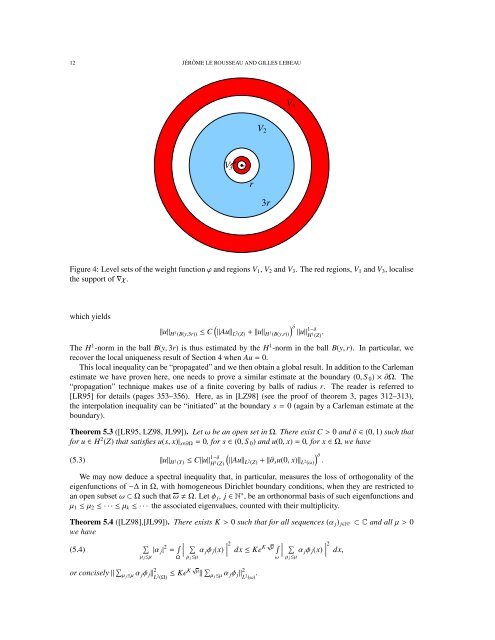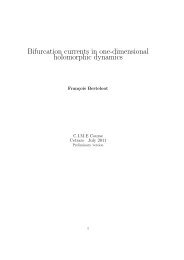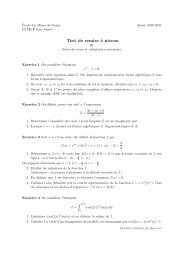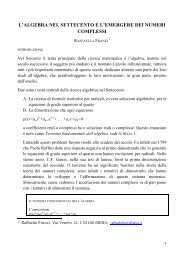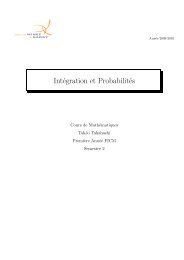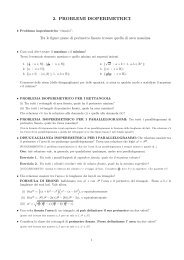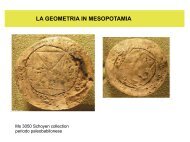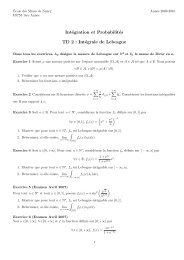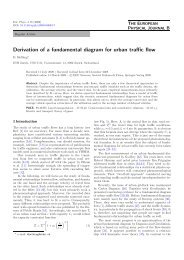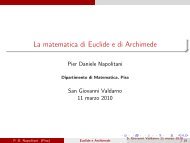on carleman estimates for elliptic and parabolic operators ...
on carleman estimates for elliptic and parabolic operators ...
on carleman estimates for elliptic and parabolic operators ...
You also want an ePaper? Increase the reach of your titles
YUMPU automatically turns print PDFs into web optimized ePapers that Google loves.
12 JÉRÔME LE ROUSSEAU AND GILLES LEBEAU<br />
V 1<br />
V 2<br />
V 3<br />
y<br />
r<br />
3r<br />
Figure 4: Level sets of the weight functi<strong>on</strong> ϕ <strong>and</strong> regi<strong>on</strong>s V 1 , V 2 <strong>and</strong> V 3 . The red regi<strong>on</strong>s, V 1 <strong>and</strong> V 3 , localise<br />
the support of ∇χ.<br />
which yields<br />
‖u‖ H 1 (B(y,3r)) ≤ C ( ) δ<br />
‖Au‖ L 2 (Z) + ‖u‖ H 1 (B(y,r)) ‖u‖<br />
1−δ<br />
The H 1 -norm in the ball B(y, 3r) is thus estimated by the H 1 -norm in the ball B(y, r). In particular, we<br />
recover the local uniqueness result of Secti<strong>on</strong> 4 when Au = 0.<br />
This local inequality can be “propagated” <strong>and</strong> we then obtain a global result. In additi<strong>on</strong> to the Carleman<br />
estimate we have proven here, <strong>on</strong>e needs to prove a similar estimate at the boundary (0, S 0 ) × ∂Ω. The<br />
“propagati<strong>on</strong>” technique makes use of a finite covering by balls of radius r. The reader is referred to<br />
[LR95] <strong>for</strong> details (pages 353–356). Here, as in [LZ98] (see the proof of theorem 3, pages 312–313),<br />
the interpolati<strong>on</strong> inequality can be “initiated” at the boundary s = 0 (again by a Carleman estimate at the<br />
boundary).<br />
Theorem 5.3 ([LR95, LZ98, JL99]). Let ω be an open set in Ω. There exist C > 0 <strong>and</strong> δ ∈ (0, 1) such that<br />
<strong>for</strong> u ∈ H 2 (Z) that satisfies u(s, x)| x∈∂Ω = 0, <strong>for</strong> s ∈ (0, S 0 ) <strong>and</strong> u(0, x) = 0, <strong>for</strong> x ∈ Ω, we have<br />
( )<br />
‖u‖ H 1 (Y) ≤ C‖u‖ 1−δ<br />
δ<br />
(5.3) ‖Au‖L<br />
H 1 (Z)<br />
2 (Z) + ‖∂ s u(0, x)‖ L 2 (ω) .<br />
We may now deduce a spectral inequality that, in particular, measures the loss of orthog<strong>on</strong>ality of the<br />
H 1 (Z) .<br />
eigenfuncti<strong>on</strong>s of −∆ in Ω, with homogeneous Dirichlet boundary c<strong>on</strong>diti<strong>on</strong>s, when they are restricted to<br />
an open subset ω ⊂ Ω such that ω Ω. Let φ j , j ∈ N ∗ , be an orth<strong>on</strong>ormal basis of such eigenfuncti<strong>on</strong>s <strong>and</strong><br />
µ 1 ≤ µ 2 ≤ · · · ≤ µ k ≤ · · · the associated eigenvalues, counted with their multiplicity.<br />
Theorem 5.4 ([LZ98],[JL99]). There exists K > 0 such that <strong>for</strong> all sequences (α j ) j∈N ∗ ⊂ C <strong>and</strong> all µ > 0<br />
we have<br />
∑<br />
(5.4)<br />
|α j | 2 = ∫<br />
∑<br />
∣ α j φ j (x)<br />
∣ 2 dx ≤ Ke K √µ ∣ ∣∣∣ ∑<br />
∫ α j φ j (x)<br />
∣ 2 dx,<br />
µ j ≤µ Ω µ j ≤µ<br />
ω µ j ≤µ<br />
or c<strong>on</strong>cisely ‖ ∑ µ j ≤µ α j φ j ‖ 2 L 2 (Ω) ≤ KeK √µ ‖ ∑ µ j ≤µ α j φ j ‖ 2 L 2 (ω) .


